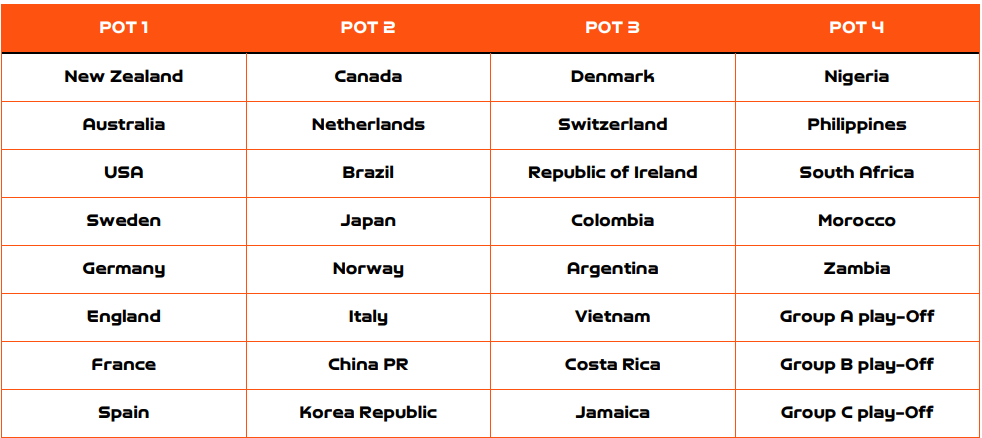African trio to learn World Cup fate live on SS

The Fifa Women’s World Cup 2023™ draw takes place in Auckland on Saturday 22 October where 32 teams will be allocated to eight groups and learn whether they will be based in Australia or New Zealand
SuperSport will broadcast and streaming the draw live from Auckland.
THE PROCEDURES
Advertisement
The draw will start by drawing a team from Pot 1 and will end by drawing the last team from Pot 4. Each pot will be completely emptied before moving on to the next one.
Fifa’s general principle is to ensure, where possible, that no group has more than one team from the same qualification zone/confederation.
This is applicable to all zones except Europe, which will be represented by 11 teams – a total that may increase to a total of 12, subject to the play-off tournament results. Each group will therefore have at least one but no more than two European teams.
2. SEEDING AND POT ALLOCATION
The 29 qualified teams and three play-off tournament slot placeholders will be allocated to four pots of eight teams each, based on the latest Fifa/Coca-Cola Women’s World Ranking released prior to the draw.
Based on the rankings, the top six ranked teams will be allocated to team pot 1 along with the co-hosts, Australia and New Zealand. The teams ranked 7 to 14 will be allocated to team pot 2. The teams ranked 15 to 22 will be allocated to team pot 3 and, finally, team pot 4 will include teams ranked 23 to 27 plus the three placeholders of the play-off tournament scheduled for 17 to 23 February 2023.
Seeded geographical allocation – play-off tournament placeholders
The play-off tournament will consist of three groups in order to determine the winners of the three remaining slots of the Fifa Women’s World Cup Australia & New Zealand 2023™. Groups A and B will each include three teams, with only one seeded team per group. Group C will include four teams, with two seeded teams. Each of the three groups will be composed of teams from different qualification zones/confederations, with no group having more than one team from the same zone.
Due to the multiple qualification zones represented in each of the three groups, the three play-off tournament placeholders in pot 4 will be identified only by the qualification zone/confederation of the seeded team(s) in that respective play-off tournament group. In play-off tournament group C, comprising four teams with two seeded teams, both seeded teams will be used to determine the geographical constraint.
This geographical constraint per play-off tournament placeholder may result in a play-off tournament winner possibly being drawn in a group with a team from the same qualification zone/confederation. In order to avoid the highly unlikely event that three European teams are drawn into the same group, the European team in the play-off tournament will be allocated to pot 1 as one of the four seeded teams in the play-off tournament draw.
DRAW PROCEDURE
1. The four pots representing the teams will be labelled team pots 1 to 4. In each team pot, there will be eight balls with the country name for each respective qualified team, including in team pot 4, three placeholders for the play-off tournament winners.
2. The eight pots representing the groups will be labelled groups A to H. In each pot, there will be four balls with the group position numbers 1, 2, 3 and 4 for each respective group.
3. The draw will start by drawing a team from pot 1 and will end by drawing the last team from pot 4. Each team pot will be completely emptied before moving on to the next pot.
4. A ball from a team pot will be drawn, followed by a ball from one of the group pots, thus determining the position to which the respective team is allocated within the group.
DRAW CONSTRAINTS
1. In pot 1, New Zealand and Australia will be identified by two different coloured balls respectively. They will be pre-assigned to positions A1 (New Zealand) and B1 (Australia) as co-hosts.
2. The remaining six teams in pot 1 will automatically be drawn into position 1 of each remaining group (in order from group C to H), with each position 1 ball being identified by a different colour.
3. Fifa’s general principle is to ensure, where possible, that no group has more than one team from the same qualification zone/confederation drawn into it. This is applicable to all zones except Europe, which will be represented by 11 teams (which may increase to a total of 12, subject to the play-off tournament results). Consequently, each group will have at least one but no more than two European teams drawn into it. Thus, three (or four) out of the eight groups will have two European teams.
4. The Play-Off Tournament for the Fifa Women’s World Cup 2023™ draw may produce an outcome where one, or more, of the play-off groups will also be required to ensure Fifa’s general principle, as outlined in point 3 above, that no group in the final competition has more than one team from the same qualification zone/confederation drawn into it (except Europe).
Whenever reasonably possible, this general principle will be addressed by a respective draw constraint for each play-off placeholder to minimise the duplication of team(s) from the same qualification zone/confederation in the final competition.
However, as each play-off tournament group will have numerous qualification zones/confederations represented in each play-off group stream and the winner from that play-off group will not be known by the time of the draw, this placeholder may provide, in one or more groups, two teams from the same qualification zone/confederation.
The number of teams from the same qualification zone/confederation may not exceed two teams per group (e.g. the play-off tournament placeholder with the European participant may not be drawn into a group that already has two European participants).
Advertisement
